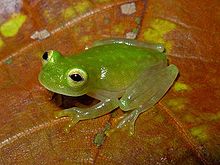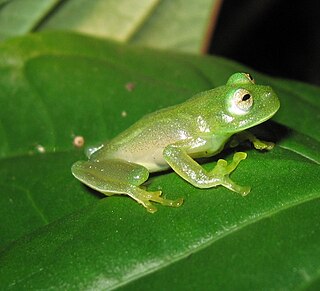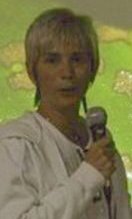| Hyalinobatrachinae | |
|---|---|
 | |
| Hyalinobatrachium fleischmanni | |
| Scientific classification | |
| Kingdom: | Animalia |
| Phylum: | Chordata |
| Class: | Amphibia |
| Order: | Anura |
| Family: | Centrolenidae |
| Subfamily: | Hyalinobatrachinae Guayasamin, Castroviejo-Fisher, Trueb, Ayarzagüena, Rada, and Vilà, 2009 |
Hyalinobatrachinae is a subfamily of glass frogs (family Centrolenidae) that was established in 2009. [1] [2] They are found in the Americas from Mexico south to southeastern Brazil and Argentina. [1]
In biological classification, a subfamily is an auxiliary (intermediate) taxonomic rank, next below family but more inclusive than genus. Standard nomenclature rules end subfamily botanical names with "-oideae", and zoological names with "-inae".

The glass frogs are frogs of the amphibian family Centrolenidae. While the general background coloration of most glass frogs is primarily lime green, the abdominal skin of some members of this family is transparent. The internal viscera, including the heart, liver, and gastrointestinal tract, are visible through the skin, hence the common name is given as glass frog. Glass frogs are arboreal, meaning they mainly live in trees, and only come out for mating season.

The Americas comprise the totality of the continents of North and South America. Together, they make up most of the land in Earth's western hemisphere and comprise the New World.
The subfamily contains 32 species in two genera: [1]
- Celsiella Guayasamin, Castroviejo-Fisher, Trueb, Ayarzagüena, Rada, and Vilà, 2009 (2 species)
- Hyalinobatrachium Ruiz-Carranza and Lynch, 1991 (30 species)
Celsiella is a small genus of glass frogs endemic to Venezuela. It was established in 2009 and named in honour of Josefa Celsa Señaris, nicknamed "Celsi", a Venezuelan herpetologist who had worked with glass frogs.

Hyalinobatrachium is a genus of glass frogs, family Centrolenidae. They are widely distributed in the Americas, from tropical Mexico to southeastern Brazil and Argentina.
AmphibiaWeb gives a slightly higher species count as it includes two additional Hyalinobatrachium species [2] that are placed in synonymy in the Amphibian Species of the World.
In scientific nomenclature, a synonym is a scientific name that applies to a taxon that (now) goes by a different scientific name, although the term is used somewhat differently in the zoological code of nomenclature. For example, Linnaeus was the first to give a scientific name to the Norway spruce, which he called Pinus abies. This name is no longer in use: it is now a synonym of the current scientific name, Picea abies.








